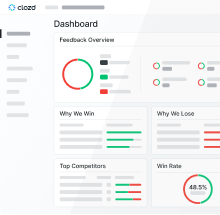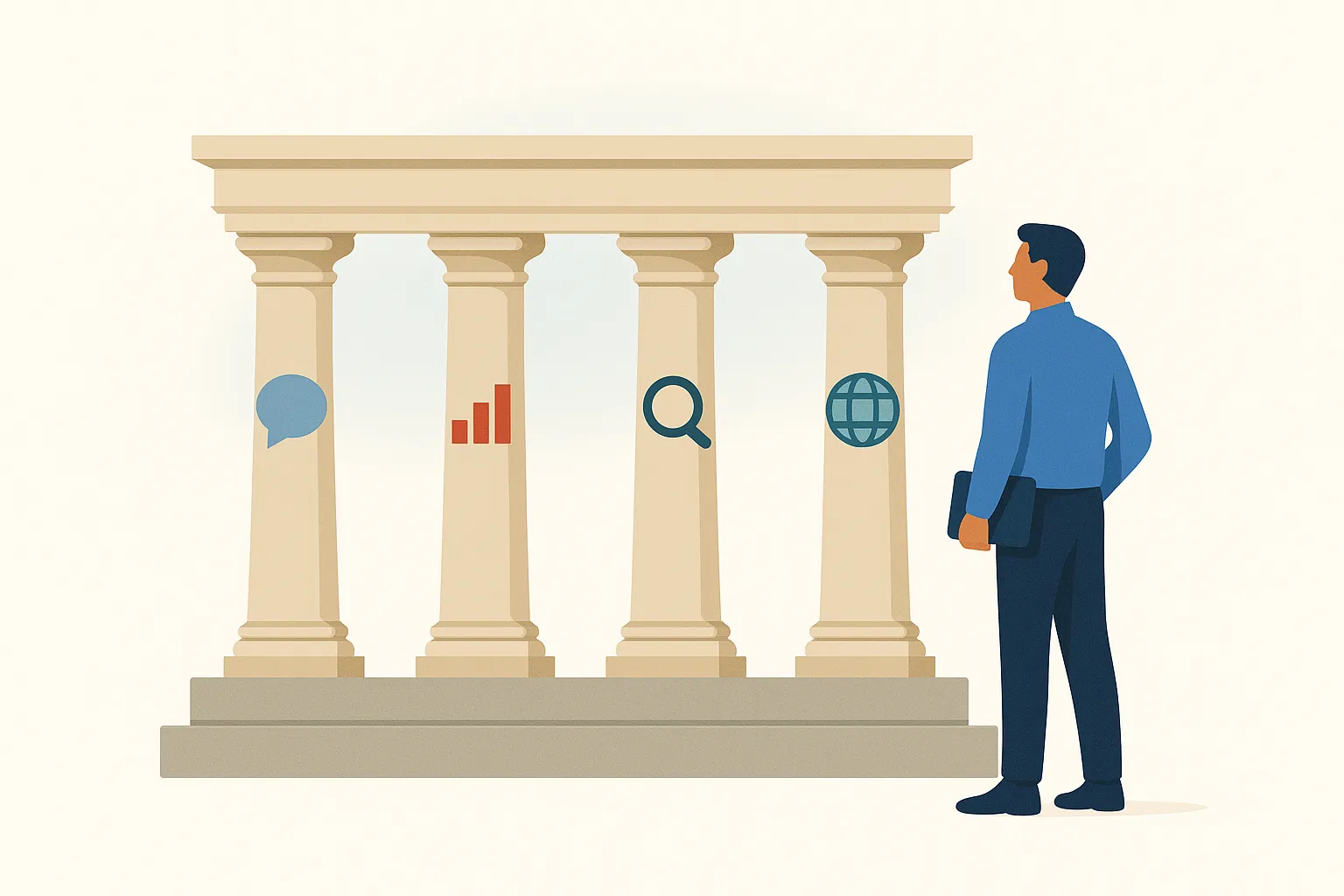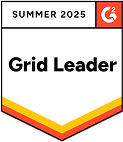Understanding the complexities of market research and customer feedback is non-negotiable for B2B leaders aiming to boost win rates, drive strategic clarity, build better products, and foster customer loyalty. To truly move the revenue needle, it’s not enough to “do research”—you need a systematic approach that puts buyer truth, not internal assumptions, at the center of your strategy.
This guide unpacks the most effective market research and feedback methods, tackles the specific questions these methods answer, and introduces the five essential pillars of high-impact market research.
Why Market Research Matters for B2B Leaders
Every executive—and every go-to-market team—faces the same fundamental questions:
- How do we win new customers, and why do we lose them?
- How do we keep our current customers happy and loyal?
- What will move the revenue needle this quarter, and what investments will create long-term growth?
If your answers are based on incomplete CRM records or secondhand sales anecdotes, you’re simply guessing. True market research captures in-depth, unbiased feedback directly from customers and buyers—transforming guesswork into actionable clarity.
According to Clozd's 2025 State of Win-Loss Analysis Report, 97% of companies currently running win-loss programs plan to maintain or increase their investment, and 63% have reported higher win rates as a direct result. That number jumps to 84% for organizations with programs established for over two years. The message is clear: rigorous research pays.
The Five Pillars of Effective Market Research
Market research that actually fuels growth and competitive advantage is built on five cornerstones:
1. Direct Buyer Feedback as the Source of Truth
CRM data is convenient and abundant—but also riddled with bias and inaccuracies. Clozd research shows that CRM “closed-lost” reasons are incorrect 85% of the time, and competitor attribution is wrong 65% of the time. The gold standard is live feedback from the people who made the buying decision.
Action: Prioritize interviews and surveys with actual buyers and customers over secondhand internal reporting.
2. Cross-Functional Integration
The best research insights don’t live in a silo. Ongoing, cross-functional programs—run collaboratively between Sales, Marketing, Product, and Customer Success—are 85% more likely to generate positive ROI than one-off projects.
Action: Bake research into the fabric of every department. Executives, enablement, customer experience, and product teams should all play a role and act on the results.
3. Multi-Channel Data Collection
The most credible insights come from a strategic blend of methods: live interviews, asynchronous interviews, buyer surveys, CRM analysis, and observation. As Clozd's data shows, 75% of organizations use at least three feedback channels to build a complete picture.
Action: Deploy multiple research methods—prioritizing buyer interviews for depth and surveys for breadth.
4. Continuous, Automated Feedback Loops
Markets move. Customer needs evolve. Win-loss analysis and feedback collection must be continuous, not sporadic. Automation is key—every closed deal should trigger outreach for feedback.
Action: Set up automated programs that capture insights in real-time to inform rapid decision-making.
5. Broad and Timely Distribution of Insights
Powerful insights are wasted if they’re trapped in quarterly reports or ignored by key stakeholders. Companies that share feedback broadly and quickly see far greater impact on win rates, alignment, and innovation.
Action: Make insights accessible and push actionable findings to the right people, at the right time—through dashboards, notifications, and real-time integrations with platforms like Slack.
Types of Market Research: Methods and Applications
Primary vs. Secondary Research
- Primary Research: Original data collected directly from buyers, customers, or the broader market—think interviews, surveys, and focus groups. This approach yields the most relevant and actionable feedback, especially when expertly conducted by third parties.
- Secondary Research: Analysis of pre-existing data like industry benchmarks, public reports, or analyst data. While valuable for context and benchmarking, these sources can’t replace the nuance of direct buyer truth.
Core Research Methods
1. Win-Loss Analysis
This is the backbone of modern B2B research. Win-loss analysis reveals the real reasons behind every sales decision. Clozd clients report up to 50% improvement in win rates and 10% faster sales rep ramp times once genuine buyer feedback becomes part of their process.
2. Customer Experience Feedback
Capturing ongoing sentiment post-sale is key for retention and reducing churn. Leading companies use structured interviews and feedback surveys at critical points—onboarding, renewal, and after service touchpoints.
3. Retention & Churn Analysis
Don’t rely on guesswork or sales speculation to understand why a customer left. Targeted post-churn interviews identify the root causes of attrition and pinpoint rescue opportunities or product gaps.
4. Product and Market Research
Customer-driven input helps prioritize development, validate messaging, and strengthen your go-to-market approach. Surveys, observational research, and rapid experimentation (e.g., pilot studies or A/B tests) validate assumptions with real buyers.
5. Competitive Intelligence
The most valuable competitive insights come straight from buyers. Incorporating win-loss data into your battlecards increases actionable intelligence by 37%. This is the missing link in most CI programs.
Building a High-Impact Customer Feedback Program
Designing Superior Surveys and Interviews
Not all questions are created equal. Use a blend of:
- Closed-Ended Questions (for quantifiable benchmarks):
- “On a scale of 1 to 10, how likely are you to recommend our solution?”
- Open-Ended Questions (to surface unfiltered insights):
- “Tell us about the one thing that nearly caused you to go with a competitor.”
- Behavioral and Performance Questions:“What did you hope to solve with our product, and did we deliver?”
- Demographic/Segmentation Questions:“What is your role in the purchase process?”
Win-loss interviews should be adaptive conversations, not rigid scripts. Skilled, unbiased third-party interviewers get far more candid and actionable feedback—nearly double the quality and depth versus internal efforts.
“Reps seldom get honest responses as to why a deal was lost, whereas Clozd steps in, acts as an unbiased third party, and walks through a detailed interview process with the client. The detail we’ve received is outstanding—much of which we use to enable our teams.”
—Shivang Patel, Sr. Director, Growth & Strategic Initiatives at FloQast
Optimizing Distribution and Collection
- Use a mix of outreach: personalized emails, CRM-integrated triggers, SMS, and even live phone calls where appropriate.
- Offer incentives to boost participation—industry benchmarks are $25–$100 for interviews, $10–$25 for surveys.
- Time your outreach immediately after a deal closure for maximum insight. Companies that collect feedback within one month post-close are twice as likely to be satisfied with the quality of feedback.
Analyzing and Activating Insights
- Track key Decision Drivers—factors that consistently sway sales outcomes.
- Filter analysis by segment: win/loss type, competitor, product, region, or team.
- Use CRM data for context, not as your primary truth source.
- Confirm or debunk internal assumptions to drive decisive action.
What Questions Can Effective Market Research Answer?
A world-class program surfaces answers to the revenue-critical questions that fuel growth:
- Why did we win or lose this customer?
- How does our product truly compare to competitors—according to buyers?
- What strengths resonate, and what gaps are losing us deals?
- What buying criteria, pain points, and objections are most influential?
- Which segments are most (and least) likely to close and renew?
- Which features or messaging actually drive purchase decisions?
- How are market trends shifting, and what white-space opportunities are emerging?
- Where are we falling short on pricing, delivery, or customer experience?
- What factors are driving customer loyalty vs. churn and attrition?
- How can we accelerate our sales cycle and boost rep ramp speed?
- What are win-back opportunities among lost deals?
- (Clozd finds that 1 in 10 closed-lost deals can realistically be won back.)
The Power of Technology: AI and Automation
Modern B2B market research doesn’t rely on guesswork or manual reporting. AI-powered insights and automated feedback loops enable scale, speed, and sophistication:
- AI-Driven Analysis: Quickly surface key themes, patterns, and predictive drivers across thousands of buyer interviews and survey responses. Clozd's Ask Clozd AI platform lets leaders instantly query win-loss data for personalized insights.
- Automated Collection: Every closed deal triggers seamless feedback outreach, ensuring your intel is always fresh and actionable.
- Integration Across Platforms: Combine win-loss analysis with call intelligence (e.g., Gong, Chorus) for a 360-degree view. Organizations that leverage both are more satisfied with pipeline coverage and new hire ramp speed.
Barriers—and How Leaders Overcome Them
Despite the upside, some organizations stall on research efforts due to resource limitations, lack of expertise, or poor cross-team alignment. Data shows that:
- Internal-only programs yield lower satisfaction rates and limited ROI (only 28% somewhat satisfied, compared to 62% satisfaction for those using expert third parties).
- The “heavy lift” of in-house analysis can be solved by working with dedicated specialists like Clozd—freeing up teams to act on data rather than wrangle it.
“Clozd’s team has been instrumental in helping me keep the ball rolling—getting these big projects off the ground and set up properly can be a heavy lift, but with Clozd it was really easy.”
—Ellen Knowles, Sr. Product Marketing Manager
ROI and Measurable Outcomes
Rigorous market research is an investment that pays back—often quickly and impressively:
- Up to 50% win rate improvement for leading organizations.
- 1.28 months faster ramp for new sales hires when armed with win-loss insights.
- Dramatic improvements in retention, messaging effectiveness, product roadmap prioritization, and even executive alignment.
- Multiple functional areas benefit: Marketing refines messaging, Product gets validation for roadmap decisions, Sales identifies effective strategies, Exec teams make data-driven calls, and Customer Success pinpoints churn risks.
“Any investment in win-loss analysis will be rapidly paid back, as it always results in increased success rates.”
—Stephane Rosenwald, CEO at RV Conseil
Take Action: Getting Started
- Secure executive and cross-functional sponsorship to elevate research as a C-suite priority.
- Audit your current data—identify gaps and leverage existing CRM, survey, and call data as a jumping-off point.
- Choose and blend feedback channels (interviews, asynchronous, surveys) for comprehensive coverage.
- Automate your programs to guarantee continuous, real-time feedback and trend monitoring.
- Analyze, share, and act—distribute insights broadly and empower leaders at every level to leverage findings for business impact.
Ready to unlock the real reasons you win and lose?
Explore the Definitive Guide to Win-Loss Analysis, calculate your potential revenue gains, or schedule a demo with Clozd’s expert team for proven, data-driven results.
Conclusion
Market research isn’t just a checkbox—it’s the decisive edge that separates high-performing B2B organizations from the competition. By anchoring your strategy in direct buyer feedback, activating insights across teams, leveraging multi-channel methods, and investing in technology and expertise, you turn every customer interaction and sales outcome into a powerful learning opportunity.
Don’t settle for “good enough” or take CRM data at face value. The source of truth is your buyer. Make systematic market research and feedback the foundation of your revenue strategy, and the lift to win rates, retention, and growth will be clear, measurable, and repeatable.
Want to see exactly how today’s leading organizations are outperforming their peers? Check out the latest Clozd resources and take the first step toward a customer-driven competitive advantage.











.svg)











.svg)

.svg)




